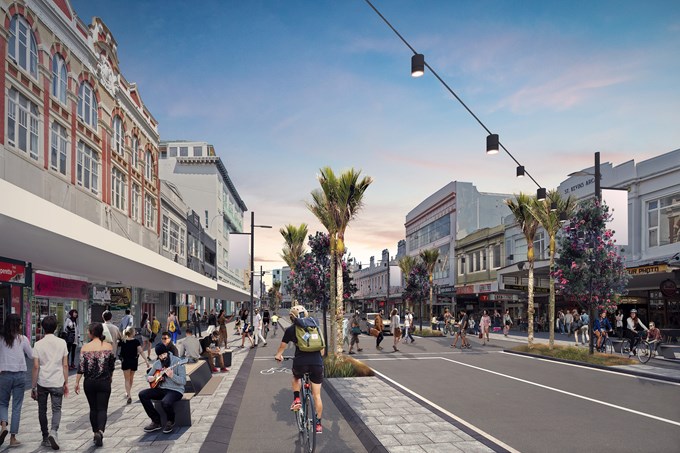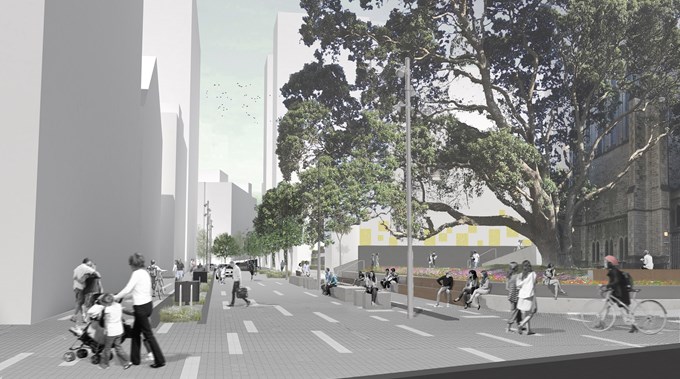Auckland’s city centre and waterfront is in for a huge transformation over the coming decade as work starts on more public open space, green parks, pedestrian-friendly thoroughfares and the installation of a modern and efficient public transport network.
The work will reconfigure Auckland’s waterfront into a more people-centric destination and progressively turn over Auckland’s central city to people rather than cars. Work also includes construction of infrastructure for the America’s Cup which is helping turn previously industrial areas into people-friendly spaces.
Mayor Phil Goff says, “We are transforming Auckland’s city centre and waterfront. Reconnecting people to our shoreline with more public, open space, places to sit, walk and talk.
“The nature of our central city is changing. It used to be empty and inert, but now we have more than 50,000 people living here, thousands of students and visitors, and 120,000 workers piling into our centre each day. It is a destination and a community, and we are making it world class.
“Our central city is important not only to our region, but our country too, generating up to 20 per cent of Auckland’s GDP and 7 per cent of the country’s economic output.
“Previously, we’ve built around the private vehicle, but the city centre’s growth simply cannot be met by dedicating ever more space to roads and car parks. So we’re giving the city back to the people with more public transport options and pedestrian-friendly streets and open space.

“We’re reconnecting Auckland to its waterfront. For decades industrial areas such as the tank farm have dominated our shoreline. Those are already coming down and making way for America’s Cup bases and a new waterfront park. We are also making Quay Street a pedestrian-friendly, green, tree-lined boulevard connected to open space at the bottom of Queen Street and around the ferry terminal.

“After the America’s Cup we expect to begin work on light rail up Queen Street and make it a destination rather than a through road with plans for more shared space and pedestrian laneways in surrounding streets such as High Street and Federal Street.
“The Linear Park, connecting Victoria Park through the city to Albert Park will be a wonderful addition to Auckland allowing cyclists, pedestrians and scooters to move about our city safely.”
Mayor Goff says High Street clearly needs an upgrade because large numbers of pedestrians are squeezed onto narrow footpaths by relatively few cars. This month the city centre business association, Heart of the City, will engage with the High Street community, asking them what changes they would like to see.
“Cars will continue to be a part of how we move about Auckland and we will need to ensure service and emergency vehicles have access, but with 37 per cent growth in city centre workforce and a five-fold increase in residents since the year 2000, public space and streets need to be rebalanced towards people.
“Our public transport system is already carrying the load, with the majority of people now entering the city centre by bus train and ferry rather than by car, and we need to transform our city centre to accommodate that.

“Our work in the central city is indicative of transformative work taking place in urban centres around Auckland.
“In Takapuna we are building a vibrant town square in place of a car park, the recent acquisition of the wharf in Onehunga begins the ball rolling on potentially building something like the Wynyard Quarter on the shores of the Manukau Harbour, and we are transforming Panmure and Manukau with more housing, businesses and shared, open space built around transport hubs.
“We are transforming Auckland. Changing the way we live, move and play. It’s good for the city and great for its people,” says Mayor Goff.

Planning Committee chair Councillor Chris Darby notes the effects the change will have on the character of our city centre.
“We’re creating a variety of distinctive, engaging public spaces that celebrate the confluence of people, land and sea.
“Our new downtown will be a series of destinations, thriving with life and enticing people to the water’s edge.
“The design of the dramatic changes afoot will reflect our unique Auckland identity and celebrate our place in the world.”
“We’re also exploring options that allow people to rediscover lower Queen Street and surrounds by creating streetscapes for people,” says Mr Darby.
Downtown engagement coming soon
Public engagement on elements of downtown work including public open space and the redevelopment of Quay Street will commence later in November with the main physical works around Quay Street and downtown due to begin in late December.

